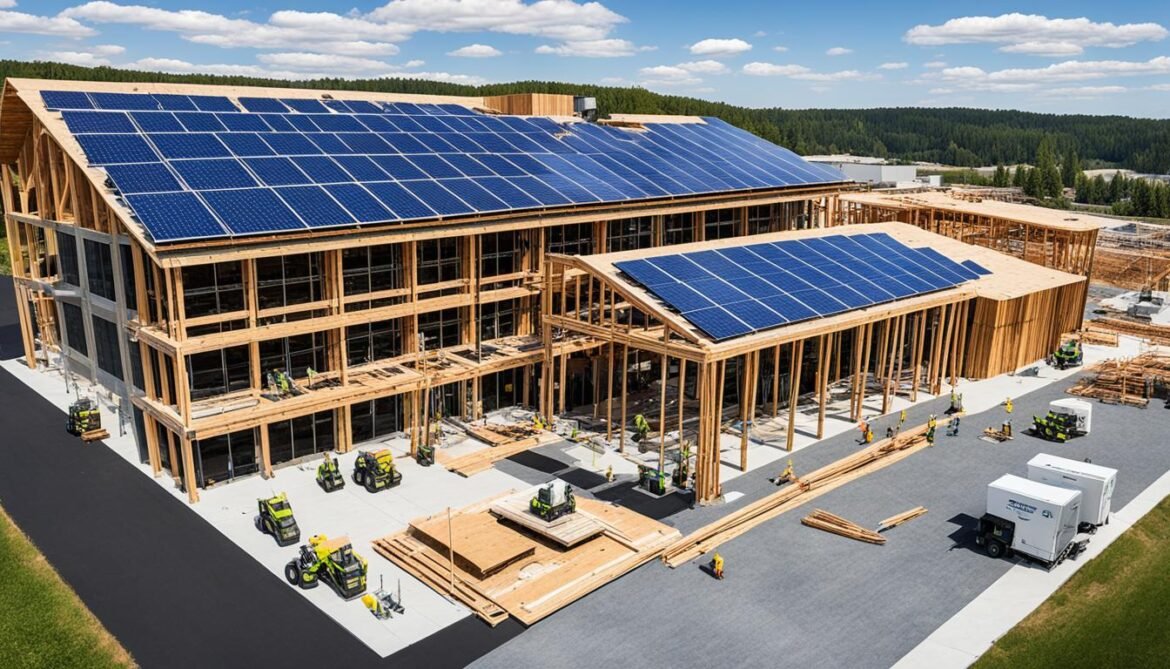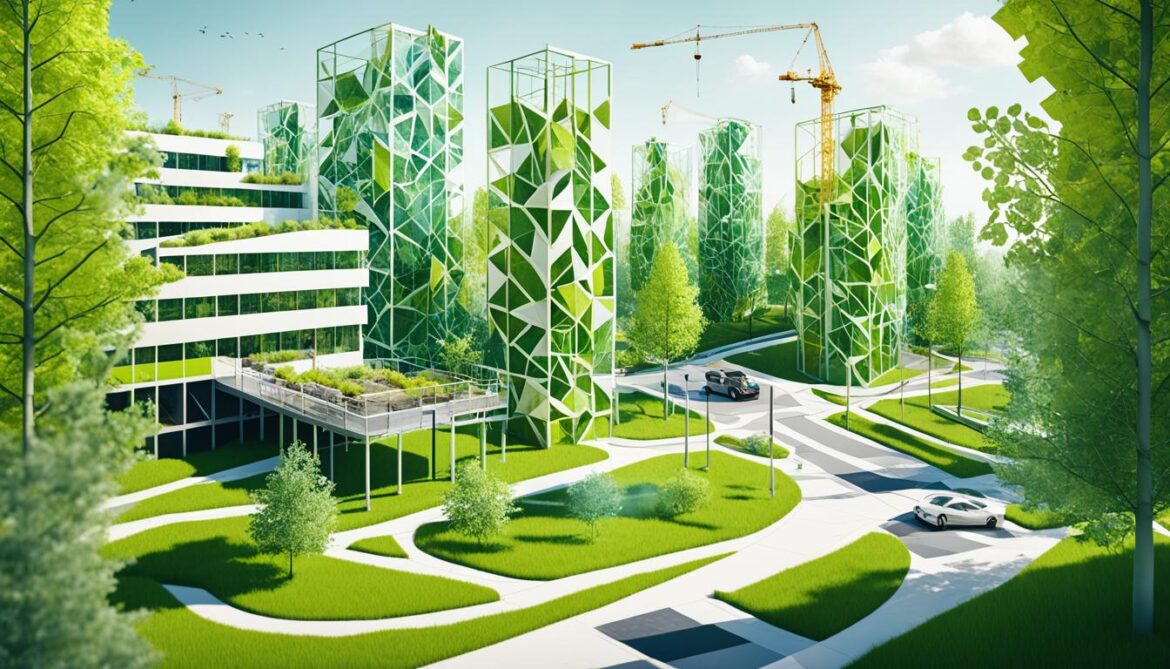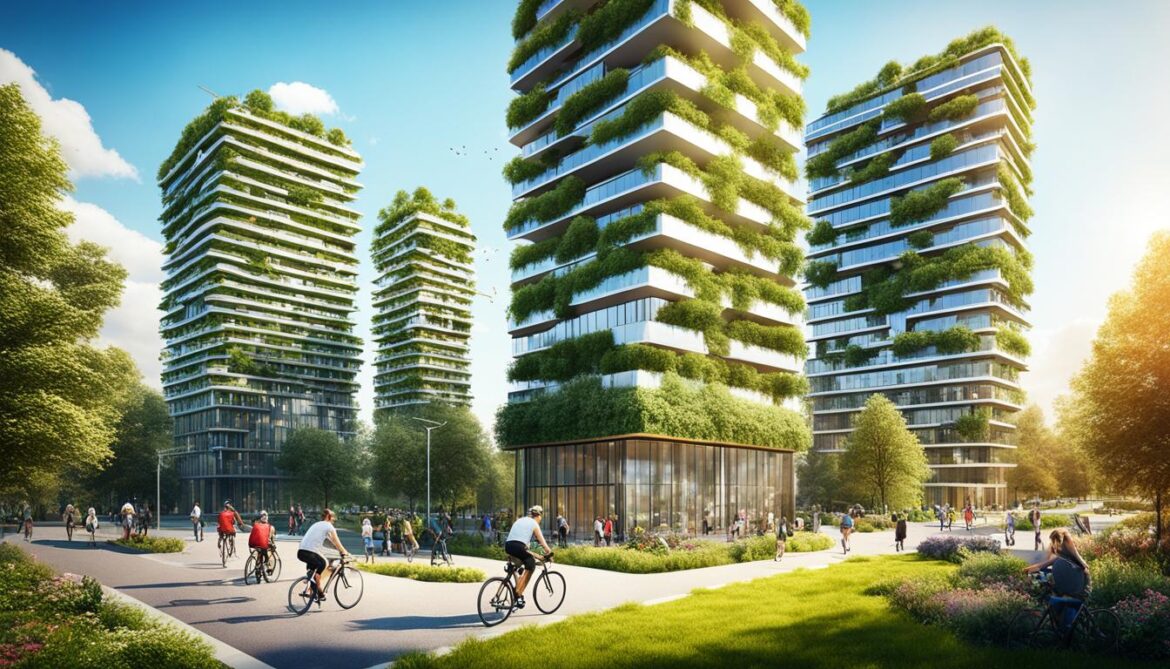Climate Change and Construction: Can They Co-Exist?
As the great Mahatma Gandhi once said,
“The earth, the air, the land, and the water are not an inheritance from our forefathers but on loan from our children. So, we have to handover to them at least as it was handed over to us.”
Climate change and construction are two seemingly contrasting concepts that are increasingly intersecting in today’s world. As the effects of climate change become more evident, the construction industry is grappling with the need to adapt its practices to mitigate environmental impacts and contribute to the global climate goals. This article explores the relationship between climate change and construction, delving into the challenges, opportunities, and strategies for building a greener and more sustainable future.

Key Takeaways:
- Embracing sustainable building practices is essential for mitigating the environmental impact of construction and addressing climate change.
- Green infrastructure development plays a crucial role in achieving carbon neutrality and creating a more sustainable built environment.
- Reducing carbon footprints through energy-efficient construction methods and the use of eco-friendly building materials is key to promoting sustainability.
- Strategic planning and compliance with changing regulations are crucial in enhancing climate resilience in the built environment.
- Environmental impact assessments and legislation play a vital role in steering construction practices towards better environmental outcomes.
The Intersection of National Infrastructure Initiatives and Climate Goals
National infrastructure initiatives play a crucial role in achieving climate goals. Governments worldwide are increasingly incorporating sustainability and resilience considerations into their infrastructure planning and development. This section will explore how national infrastructure initiatives intersect with climate goals and the impact these initiatives can have on driving sustainable construction practices.
When it comes to addressing climate change, national infrastructure initiatives provide a platform for implementing sustainable infrastructure and construction practices. These initiatives are designed to support the transition towards a low-carbon economy while ensuring the development of resilient and future-proof infrastructure.
One example of such initiatives is the United Kingdom’s National Infrastructure Strategy. The strategy sets out a vision for sustainable infrastructure investments that align with the country’s climate goals. It focuses on areas such as renewable energy, digital connectivity, and sustainable transportation, aiming to build a greener and more resilient infrastructure network.
By integrating climate goals into national infrastructure initiatives, governments can drive the adoption of sustainable construction practices. This includes promoting the use of eco-friendly materials, implementing energy-efficient designs, and incorporating green infrastructure elements such as green roofs and urban forests.

Sustainable infrastructure not only reduces the carbon footprint of construction projects but also enhances their resilience to the impacts of climate change. This includes designing buildings that can withstand extreme weather events, implementing flood-resistant measures, and utilizing renewable energy sources to reduce reliance on fossil fuels.
Furthermore, national infrastructure initiatives also provide opportunities for job creation and economic growth through the development of sustainable construction projects. As governments prioritize climate goals and sustainable infrastructure, there is a growing demand for skilled workers in fields such as green building design, renewable energy installation, and sustainable materials manufacturing.
Examples of National Infrastructure Initiatives and their Impact on Sustainable Construction
| National Infrastructure Initiative | Climate Goals | Impact on Sustainable Construction |
|---|
| Germany’s Energiewende | Transition to Renewable Energy | Promotes the construction of energy-efficient buildings and the use of renewable energy sources |
| China’s Belt and Road Initiative | Resilient Infrastructure Development | Prioritizes the development of sustainable and climate-resilient infrastructure along transportation corridors |
| United States’ Green New Deal | Carbon Neutrality and Job Creation | Invests in sustainable construction projects to reduce carbon emissions and stimulate economic growth |
Table: Examples of National Infrastructure Initiatives and their Impact on Sustainable Construction
By integrating climate goals with national infrastructure initiatives, governments can drive the transition towards sustainable construction practices. These initiatives provide a framework for implementing environmentally conscious design and construction methods, while also creating opportunities for economic growth and job creation in the green sector.
Adapting Construction Practices for Climate Resilience
Adapting construction practices is crucial in ensuring the resilience of the built environment in the face of climate change. To meet this challenge, construction regulations need to evolve, innovative building strategies and materials must be embraced, and strategic planning and compliance should be prioritized.
Changing Construction Regulations
In order to align construction practices with environmental goals, it is imperative to modify existing construction regulations. These regulations should emphasize the use of sustainable materials, energy-efficient construction methods, and climate-resilient designs. By implementing stricter guidelines and standards, the construction industry can make significant progress towards reducing its environmental impact and increasing climate resilience.
Building Strategies and Materials for the Future
Building strategies and materials play a critical role in enhancing climate resilience. Embracing sustainability practices such as green infrastructure development, low-carbon construction techniques, and the use of eco-friendly building materials can significantly reduce the carbon footprint of construction projects. Additionally, integrating climate-resilient designs, such as natural disaster-resistant structures, can enhance the ability of buildings to withstand extreme weather events.
Strategic Planning and Compliance
Strategic planning and compliance with environmental regulations are integral to ensuring climate resilience in construction projects. By integrating climate risk assessments into the planning phase, construction professionals can identify vulnerabilities and develop appropriate adaptation strategies. Furthermore, complying with sustainability certifications such as LEED (Leadership in Energy and Environmental Design) and BREEAM (Building Research Establishment Environmental Assessment Method) can demonstrate a commitment to sustainable practices and help mitigate climate-related risks.
| Benefit | Description |
|---|
| Enhanced climate resilience | Adopting sustainable practices and materials strengthens the ability of buildings to withstand the impacts of climate change. |
| Reduced environmental impact | Changing construction practices reduces carbon emissions and promotes resource conservation. |
| Improved public perception | Engaging in climate-resilient and sustainable construction practices enhances a company’s reputation and attracts environmentally conscious clients. |
| Long-term cost savings | Investing in energy-efficient technologies and strategies can lead to lower operating costs over the life cycle of a building. |
By adapting construction practices to prioritize climate resilience, the industry can contribute to a more sustainable and resilient built environment. Changing construction regulations, embracing innovative building strategies and materials, and ensuring strategic planning and compliance are essential steps towards achieving these goals.
Climate Change and Construction: An Inevitable Partnership?
Climate change and the construction industry are increasingly intertwined, shaping the future of the built environment. As the world grapples with the impacts of climate change, the construction industry has emerged as a key player in addressing environmental challenges and promoting sustainable practices.
Partnership between climate change and the construction industry is inevitable, as the industry’s actions have a significant impact on the environment. By adopting sustainability practices, the construction industry can minimize its environmental footprint and contribute to the global effort of combating climate change.

Construction projects have a substantial environmental impact, from resource consumption to waste generation. Sustainability practices in construction involve incorporating energy-efficient technologies, using eco-friendly building materials, and implementing efficient waste management strategies.
These sustainability practices not only reduce the environmental impact of construction projects but also contribute to resource conservation and cost savings. By partnering with climate change and prioritizing sustainable practices, the construction industry can play a crucial role in creating a greener and more resilient built environment.
In this evolving partnership, the construction industry is uniquely positioned to drive change and innovation. By embracing sustainable building practices and integrating environmental considerations into project planning, construction companies can become agents of positive change in the fight against climate change.
Furthermore, collaboration between the construction industry and other stakeholders, such as governments, environmental organizations, and communities, is essential for shaping a sustainable future. By working together, these partnerships can foster knowledge sharing, drive policy changes, and create a collective impact that goes beyond individual projects.
In conclusion, the partnership between climate change and the construction industry is inevitable. By embracing sustainability practices and addressing the environmental impact of construction projects, the industry can contribute to a more sustainable and resilient built environment. Together, we can shape a better future that prioritizes both the needs of the present and the well-being of future generations.
Green Infrastructure Development: A Path to Carbon Neutrality
Green infrastructure development offers a promising path towards achieving carbon neutrality in the construction sector. By integrating sustainable practices and innovative solutions, the industry can reduce its environmental impact and contribute to a greener and more sustainable future.
Advancements in Eco-friendly Building Designs
Eco-friendly building designs play a pivotal role in green infrastructure development. These designs prioritize energy efficiency, resource conservation, and the use of sustainable building materials. By implementing eco-friendly designs, construction projects can significantly reduce their carbon footprint and minimize their environmental impact.
The incorporation of energy-efficient systems, such as smart lighting and heating/cooling systems, allows buildings to operate more efficiently, reducing energy consumption and greenhouse gas emissions. Additionally, the use of passive design strategies, such as natural ventilation and daylighting, can optimize energy usage and provide a healthier and more comfortable indoor environment.

Investing in Renewable Energy Sources
Investing in renewable energy sources is another crucial aspect of green infrastructure development. By harnessing the power of clean and renewable energy, construction projects can significantly reduce their reliance on fossil fuels and decrease their carbon emissions.
Utilizing solar panels, wind turbines, or geothermal systems can generate sustainable energy for onsite electricity needs, reducing the project’s environmental impact and dependence on non-renewable resources. Furthermore, integrating energy storage systems can store excess energy and provide backup power, increasing the resilience and efficiency of the building.
The Role of Green Certifications in Promoting Sustainable Building
Green certifications play a vital role in promoting sustainable building practices and recognizing environmentally responsible construction projects. Certifications such as LEED (Leadership in Energy and Environmental Design) and BREEAM (Building Research Establishment Environmental Assessment Method) provide guidelines and standards for designing, constructing, and operating sustainable buildings.
These certifications consider various aspects, including energy efficiency, water conservation, waste reduction, and indoor environmental quality. By obtaining green certifications, construction projects demonstrate their commitment to sustainability, gain recognition in the market, and inspire other developers to adopt eco-friendly practices.
Moreover, green certifications provide building occupants with assurance that the structure meets high environmental standards and offers a healthier and more sustainable living or working environment.
As the construction industry continues to adopt green infrastructure development, it will contribute significantly to the global efforts towards carbon neutrality, ensuring a more sustainable and resilient built environment for future generations.
| Eco-friendly Building Designs | Investing in Renewable Energy Sources | Green Certifications |
|---|
| Prioritize energy efficiency and resource conservation | Reduce reliance on fossil fuels | Recognize environmentally responsible practices |
| Use sustainable building materials | Harness clean and renewable energy | Elevate market recognition |
| Integrate passive design strategies | Decrease carbon emissions | Assure high environmental standards |
Reducing Carbon Footprints with Energy Efficient Construction Methods
Reducing carbon footprints is a key focus in sustainable construction. As the construction industry strives to minimize its environmental impact, energy efficient construction methods have emerged as a crucial solution. By embracing modern building techniques that prioritize energy efficiency and resource conservation, construction companies can significantly reduce their carbon emissions and contribute to a more sustainable future.
Embracing Modern Building Techniques for Sustainability
Modern building techniques offer innovative and effective ways to enhance sustainability in construction projects. Incorporating energy efficient technologies, such as passive design principles and advanced insulation systems, can significantly reduce energy consumption and carbon emissions. By optimizing building designs to maximize natural lighting and ventilation, construction projects can also minimize reliance on artificial lighting and cooling systems, further reducing energy use and environmental impact.
Furthermore, the use of eco-friendly building materials, such as sustainable timber and recycled materials, can greatly contribute to carbon footprint reduction. These materials not only have lower embodied energy but also possess excellent thermal properties, enhancing energy efficiency within buildings. By adopting these modern building techniques, construction companies can create structures that are not only environmentally friendly but also provide a healthier and more comfortable living environment for occupants.
Impact of Factory-Built, Modular Construction on Emissions
Factory-built, modular construction has gained traction in recent years as a sustainable alternative to traditional construction methods. This innovative approach involves constructing building components in a controlled factory environment and then assembling them on-site. The factory-controlled conditions minimize waste, optimize material usage, and reduce transportation emissions. As a result, modular construction significantly reduces carbon emissions compared to traditional construction methods.
The use of prefabricated modules also allows for better integration of energy efficient systems, such as highly efficient HVAC systems and renewable energy technologies like solar panels. These modules can be designed and manufactured to be energy-efficient, ensuring reduced energy consumption and lower carbon footprints throughout the building’s lifecycle. Additionally, the shorter construction time associated with modular construction further contributes to reduced energy consumption and emissions, as it minimizes the use of heavy machinery and construction vehicles.

Sustainable Building Practices: From Theory to Reality
Transitioning sustainable building practices from theory to reality is vital for creating a greener built environment. By implementing sustainable building practices, construction professionals can contribute to environmental conservation and promote long-term sustainability.
Implementing sustainable building practices involves incorporating best practices, case studies, and real-world examples that demonstrate the practical application of sustainable construction principles. This approach enables the industry to learn from successful projects and adapt strategies to diverse contexts.
Best practices play a crucial role in guiding construction professionals towards environmentally responsible decision-making. These practices encompass a range of strategies, such as energy-efficient designs, water conservation measures, waste management systems, and the use of eco-friendly materials. By adopting these practices, construction projects can minimize their environmental impact and reduce resource consumption.
Case studies provide valuable insights into the positive outcomes of sustainable building practices. They showcase real-world examples of successful projects that prioritize energy efficiency, reduce carbon footprints, and promote environmentally friendly designs. Case studies highlight both the environmental and economic benefits of sustainable construction, demonstrating that eco-conscious decisions can lead to cost savings and improved building performance.
In addition to best practices and case studies, real-world examples play a crucial role in inspiring and encouraging the implementation of sustainable building practices. These examples showcase successful projects that have demonstrated sustainable strategies, innovative designs, and resource-efficient construction techniques. By highlighting these achievements, construction professionals can gain practical knowledge and inspiration for their own projects.
| Benefits of Sustainable Building Practices | Real-World Examples |
|---|
- Reduced environmental impact
- Lower energy and water consumption
- Improved indoor air quality
- Enhanced occupant health and well-being
| - The Edge, Amsterdam
- One Angel Square, Manchester
- Bullitt Center, Seattle
- Dockside Green, Victoria
|
By integrating these sustainable building practices into construction processes, the industry can proactively address climate change, reduce greenhouse gas emissions, and promote a more sustainable future. Implementing these practices not only benefits the environment but also contributes to cost savings, improved building performance, and enhanced occupant comfort and well-being. The transition from theory to reality marks a fundamental shift towards a greener and more sustainable built environment for generations to come.
Environmental Impact Assessments: Steering Construction for Better Outcomes
When it comes to construction projects, considering their environmental impact is crucial for achieving better outcomes. Environmental impact assessments (EIAs) play a vital role in ensuring that construction projects are undertaken with careful consideration of their long-term effects on the environment.
Assessing the long-term effects of construction projects is essential to understand their potential implications on the surrounding ecosystems, biodiversity, and natural resources. By conducting thorough EIAs, construction professionals can identify potential risks and develop strategies to minimize the negative environmental impacts.
Legislation and policy also play a significant role in shaping construction practices and minimizing their environmental impact. Governments around the world have implemented regulations that require developers and construction companies to undergo EIA processes and comply with specific environmental standards. These regulations help ensure that construction projects align with sustainable development objectives and contribute positively to the ecological and social well-being of communities.
By considering the long-term effects of construction projects through rigorous EIAs and adhering to legislation and policy, the construction industry can steer projects towards better environmental outcomes. This proactive approach helps mitigate negative environmental impacts and ensures that construction practices are environmentally responsible and sustainable in the long run.

Eco-friendly Building Materials: Innovation and Practicality
In today’s construction industry, the use of eco-friendly building materials has become imperative in reducing its environmental impact. As sustainability practices continue to gain momentum, there is a continuous search for low-impact building resources that can help minimize the carbon footprint of construction projects. Alongside this quest for sustainable materials, technological advancements in material production have paved the way for the development of more environmentally conscious construction options.
The Continuous Search for Low-Impact Building Resources
The construction industry is committed to finding and utilizing low-impact resources that minimize environmental harm. By incorporating sustainable materials into construction projects, such as responsibly sourced timber, recycled steel, and reclaimed materials, builders can significantly reduce their reliance on traditional high-impact resources. These alternatives not only reduce the demand for virgin materials but also help mitigate waste and promote better resource management within the construction sector.
Technological Advancements in Material Production
Technological advancements have revolutionized the production processes of building materials, allowing for the creation of sustainable options that are both innovative and practical. From the development of eco-friendly concrete that incorporates recycled aggregates to the use of sustainable insulation materials like hempcrete and cellulose insulation, technology provides the construction industry with a range of eco-friendly choices. These advancements enable builders to construct energy-efficient and environmentally friendly structures without compromising on structural integrity or aesthetic appeal.

In conclusion, the utilization of eco-friendly building materials is vital for reducing the environmental impact of construction. The continuous search for low-impact building resources, coupled with technological advancements in material production, allows the construction industry to embrace sustainable practices that align with global environmental goals. By incorporating these innovative and practical materials into construction projects, builders can contribute to the creation of a more sustainable and environmentally conscious built environment.
Conclusion
In conclusion, the coexistence of climate change and construction necessitates the adoption of sustainable building practices to mitigate environmental impacts and promote resilience. By embracing green infrastructure development, reducing carbon footprints, implementing sustainable building practices, and utilizing eco-friendly materials, the construction industry can contribute to global efforts towards achieving carbon neutrality and creating a more sustainable and resilient built environment.
FAQ
Can climate change and construction co-exist?
Yes, climate change and construction can co-exist. However, it is crucial for the construction industry to adopt sustainable building practices to mitigate environmental impacts and contribute to global climate goals.
How do national infrastructure initiatives intersect with climate goals?
National infrastructure initiatives play a crucial role in achieving climate goals by incorporating sustainability and resilience considerations into infrastructure planning and development.
What can be done to enhance climate resilience in the built environment?
To enhance climate resilience, construction regulations need to be changed to align with environmental goals. Additionally, innovative building strategies and materials that promote sustainability and resilience should be embraced, and strategic planning and compliance should be prioritized to mitigate climate risks in construction projects.
How does climate change shape the construction industry?
Climate change and the construction industry are increasingly intertwined. The industry plays a significant role in addressing environmental challenges and promoting sustainable practices to create a more resilient built environment.
How does green infrastructure development contribute to carbon neutrality in the construction sector?
Green infrastructure development prioritizes energy efficiency and resource conservation in building designs, invests in renewable energy sources, and promotes sustainable construction practices through green certifications, helping to achieve carbon neutrality.
What is the importance of reducing carbon footprints in sustainable construction?
Reducing carbon footprints is essential in sustainable construction. This can be achieved by embracing energy-efficient construction methods and utilizing factory-built, modular construction to reduce emissions and promote sustainability in the industry.
How can sustainable building practices be implemented in the real world?
Sustainable building practices can be implemented through the exploration of best practices, case studies, and real-world examples that demonstrate the practical application of sustainable construction principles.
What role do environmental impact assessments play in construction projects?
Environmental impact assessments are crucial in steering construction projects towards better environmental outcomes. They assess the long-term effects of construction projects on the environment and help shape and regulate construction practices to minimize their environmental impact.
Why is the use of eco-friendly building materials important in construction?
The use of eco-friendly building materials is vital in reducing the environmental impact of construction. Continuous efforts are being made to find low-impact building resources, including sustainable and recycled materials. Technological advancements in material production also promote the development of more environmentally conscious construction materials.
Source Links


























Post comments (0)